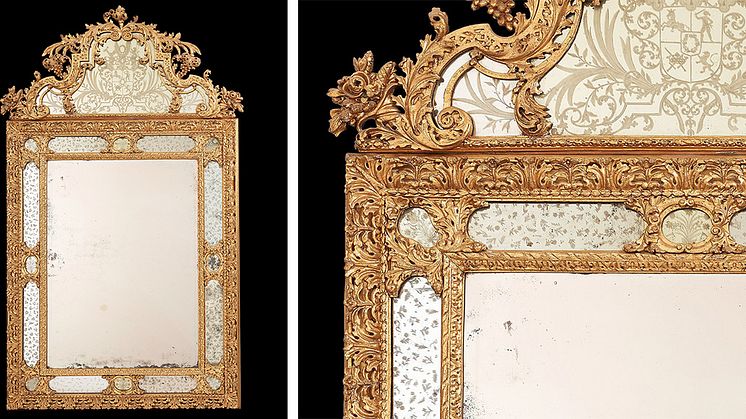
Press release -
New acquisition: Mirror ordered by Count Fabian Wrede in the 1690s
A mirror just acquired by Nationalmuseum is among the most magnificent examples of Swedish Baroque ever produced. The ornately carved and gilded frame contains engraved, inset plate glass. The mirror’s unusually well-documented origins go back to the initial order.
Count Wrede (1641-1712) was a top official who had earned the unwavering trust of King Karl XI. Following a career as Viborg County Governor, he contributed to preparations for the compulsory restitution of alienated estates in 1680. He was the Lord Marshall for the 1682 session of the Parliament. He subsequently held a number of prominent official positions. Promoting mercantilism in the private sector was among Wrede’s obsessions. It wasn’t long before he was elevated to countship and became one of the wealthiest Swedes alive. His political fortunes declined, however, after he advocated a more defensive military policy than Karl XII was pursuing. In 1711, he was pushed out of nearly all his positions.
The frame of the large, 195-centimetre mirror features a lace border, acanthus, cornucopia, grape clusters and flowers. The inset plate glass is adorned with engraved, scattered flowers. The top of the mirror brandishes a meticulously engraved coat of arms for the Wrede lineage. Though not signed, the mirror is most certainly the handiwork of Burchard Precht (1651–1738). As the leading sculptor of his day, he received many royal and ecclesiastical projects, often in collaboration with court architect Nicodemus Tessin the Younger. Born in Bremen and educated in Hamburg, he emigrated to Stockholm in the 1670s. His workshop produced furniture, frames and crests for the court and nobility. The evidence strongly suggests that he was able to polish and silver glass. No wonder he is regarded as one of the first Swedish mirror craftsmen. The high quality of plate glass is due to the requirement back then that mirrors be imported.
Engraving the glass with an artistic touch was a daunting challenge. The technique had been resurrected in Europe during the early seventeenth century and had become a coveted skill. A handful of engravers passed through Sweden from the 1650s to 1680s. After Kristoffer Elstermann arrived in the 1690s, engraving assumed its rightful place in the Swedish glassmaking tradition. The first time Elstermann shows up in the accounts is 1691, when he received an order from Queen Dowager Hedvig Eleonora for the new royal chapel at the Tre Kronor castle. He had his own workshop and later obtained projects from the Kungsholm Glassworks as well. He was skilful at engraving various motifs that went well with the surface and shape of the particular object. He exerted a major influence on Swedish engraving until his death in 1721. The glassworks have never produced such high-quality engravings as during that period.
The panels in the frame of the Wrede mirror have the same types of scattered flowers as the glasswork used, but their placement is less standardized than later on. The noble coat of arms at the top typifies the dexterity of Elstermann’s works. More than likely, he engraved it himself.
Precht’s mirrors also became more streamlined and formulaic as time went on. Cast pewter strips replaced sculptured wood, and the engraved adornment of the frame was painted white. No portents of such austerity are visible in this mirror, which is why it can be dated with so much exactitude to the 1690s.
Wrede’s impact on the appearance of the mirror cannot be overestimated. It’s hard to miss signs of his close association with the court and contemporary vogues, including new ornamentation techniques and Precht’s carved, gilded furniture. He had the financial resources to purchase such an exquisite object, and the cornucopia is a nod to his mercantilist inclinations. The same mindset no doubt convinced him that the mirror should be produced in Sweden to the extent possible.
The records clearly show that his daughter Sohpia inherited the mirror when she married Erik Axelsson Sparre in 1707. It has been passed down from generation to generation ever since.
Acquisition of the mirror by Nationalmuseum was made possible by an Axel Hirsch endowment. The museum has no funds with which to purchase handicrafts and works of art but is wholly reliant on donations and private foundations.
Inventory number: NMK 114/2017
Additional information
Micael Ernstell, Curator, micael.ernstell@nationalmuseum.se, phone +46 8-519 543 92
Mattias Robertson, Press Officer, press@nationalmuseum.se, phone +46 767-23 46 32
Related links
Categories
Nationalmuseum is Sweden’s museum of art and design. The collections comprise older paintings, sculpture, drawings and graphic art, and applied art and design up to the present day. The museum building is currently under renovation and scheduled to open again October 13, 2018. In the meantime, the museum will continue its activities through collaborations both in Sweden and abroad. Nationalmuseum has partnerships with Svenska Dagbladet and the Grand Hôtel Stockholm.

